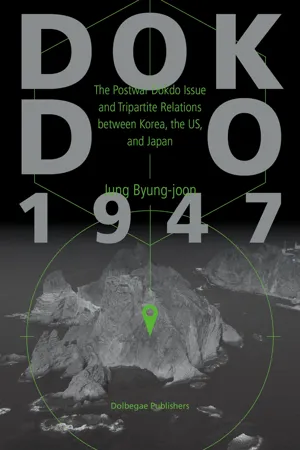
Dokdo 1947
The Postwar Dokdo Issue and Tripartite Relations between Korea, the US, and Japan
- English
- ePUB (mobile friendly)
- Available on iOS & Android
Dokdo 1947
The Postwar Dokdo Issue and Tripartite Relations between Korea, the US, and Japan
About this book
1947 was a watershed year for the Dokdo issue. Many think that the differences between Korea and Japan over the historical title to the island are what caused the Dokdo issue. From my studies, however, I came to learn that the Dokdo issue is a ramification, or one of the shadows, of the sway and decision power the U.S. exerted on the post-war policies for Northeast Asia. Therefore, it would be more accurate to say that the dispute over the sovereignty of Dokdo after the Second World War involves the U.S. as well and that it is a matter of regional and international politics rather than that of history. \"The idea for this book came about in 2001 when I was studying the U.S. State Department's diplomatic documents from the 1950s in the National Archives and Records Administration. The records were telling a different story from what average Koreans know about Korea-Japan relations and the Dokdo issue. Although much of the documents about Korea-Japan relations and the Dokdo issue were still classified, I was able to see that the 1951 Treaty of San Francisco was the starting point of, as well as a turning point for, the U.S. policies and diplomatic decisions on Dokdo. So I started delving into the archives of the U.S., Japan, Korea, and the UK. I looked into how the San Francisco Treaty—which officially settled the war between Japan and the U.S.-led Allies—relates to Korea and how it became a turning point for Korea-Japan relations, Korea-U.S. relations, and U.S.-Japan relations. I found myself on a journey of exploring how the San Francisco system shaped the new post-war order in Northeast Asia; how Korea, the U.S., Japan, and the UK viewed and responded to Japan's territorial issues including that of Dokdo; and how Korea-U.S. relations, U.S.-Japan relations, and Korea-Japan relations had changed over the years. This book is a summary of what I learned during my journey, and it delineates how and when Korea, the U.S., and Japan began introducing policies, as they became more aware of Dokdo after the Second World War, and how these policies evolved before and after the San Francisco Treaty.\" (_ Excerpt from the Preface)
Frequently asked questions
- Essential is ideal for learners and professionals who enjoy exploring a wide range of subjects. Access the Essential Library with 800,000+ trusted titles and best-sellers across business, personal growth, and the humanities. Includes unlimited reading time and Standard Read Aloud voice.
- Complete: Perfect for advanced learners and researchers needing full, unrestricted access. Unlock 1.4M+ books across hundreds of subjects, including academic and specialized titles. The Complete Plan also includes advanced features like Premium Read Aloud and Research Assistant.
Please note we cannot support devices running on iOS 13 and Android 7 or earlier. Learn more about using the app.
Information
Table of contents
- Cover
- Author
- Copyright
- Preface
- Introduction
- Chapter 1 Korea’s Perception of Dokdo: Exploration of Dokdo(1947) and Bombing of Dokdo (1948)
- Chapter 2 Japan’s Preparations for the Peace Treaty and Perception of Dokdo(1945~50): Dokdo and Ulleungdo as Japanese Territory
- Chapter 3 The US Draft Treaty of Peace with Japan and Its Relation to Dokdo (1947-1951)
- Chapter 4 British Draft Treaties of Peace with Japan and Anglo-American Consultations (1951)
- Chapter 5 US-Japan Negotiations (1951)
- Chapter 6 The Korean Government’s Response to the Treaty of Peace with Japan and Korea-US Negotiations (1951)
- Chapter 7 Invisible Battle: Prelude to the Dispute over Dokdo and Actions taken by Korea, the United States, and Japan
- Bibliography